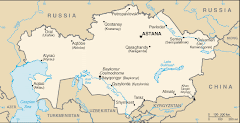 Today was the celebration of Nauryz, locally referred to as "Kazakh New Year" but actually having roots in the Persian/Zoroastrian celebration of spring. Usually this holiday entails a big public event in Almaty, and today they had a day-long concert in the "Old Square" where the parliament building used to be. At noon they did an interesting show all about the various animals in the Asian zodiac (see my post about Asian New Year) - they explained the significance of each animal, then someone (an actual or aspiring pop star) sang a song in their honor.
Today was the celebration of Nauryz, locally referred to as "Kazakh New Year" but actually having roots in the Persian/Zoroastrian celebration of spring. Usually this holiday entails a big public event in Almaty, and today they had a day-long concert in the "Old Square" where the parliament building used to be. At noon they did an interesting show all about the various animals in the Asian zodiac (see my post about Asian New Year) - they explained the significance of each animal, then someone (an actual or aspiring pop star) sang a song in their honor.I wandered around for a while taking in the semi-organized chaos. Lots of people were selling food, toys, and Muslim artifacts (prayer beads, Korans, etc.). Others were selling the traditional holiday soup Nauryz-kozhe -- supposedly it should contain seven ingredients (this refers back to the Persian Noruz tradition of placing seven items on a table, each representative of new life). Unfortunately, though, it tastes pretty nasty. And even worse is the fact that many of these vendors re-use the bowls and spoons used for serving the kozhe without washing them (or only quickly rinsing them in questionable water).
A couple American friends and I walked around the Old Square checking out the scene, watching a little bit of the main stage show, then went around to the back of the square, where there were
 several traditional Kazakh felt houses (yurts, in Kazakh "kiez ui") where apparently the mayor of Almaty was hosting a day-long feast for the day's performers and other notable guests. Almost by accident, I saw Akerke's friend Sabir, who works in the mayor's office in the department of culture - he was working as a sort of guard/logistical support guy for the day. He told me that Akerke was there, because she had played for the mayor earlier, and invited me into one of the yurts!
several traditional Kazakh felt houses (yurts, in Kazakh "kiez ui") where apparently the mayor of Almaty was hosting a day-long feast for the day's performers and other notable guests. Almost by accident, I saw Akerke's friend Sabir, who works in the mayor's office in the department of culture - he was working as a sort of guard/logistical support guy for the day. He told me that Akerke was there, because she had played for the mayor earlier, and invited me into one of the yurts! I ended up spending about an hour just talking with the people there, including several British journalists who were covering the day's events. I gave one of them a crash-course in Kazakh music history (hopefully she will credit me!!) and sat in on some of the photo opps. Woo hoo! Oh, and of course was served a huge bowl of Naruyz-kozhe... I tried to be polite and eat a few bites, but was conveniently distracted by the various conversations going on.
So, with Nauryz now over and done with I guess it's officially spring here in Almaty - the weather's growing steadily warmer and I'm starting to pine for the cool mountain air...










